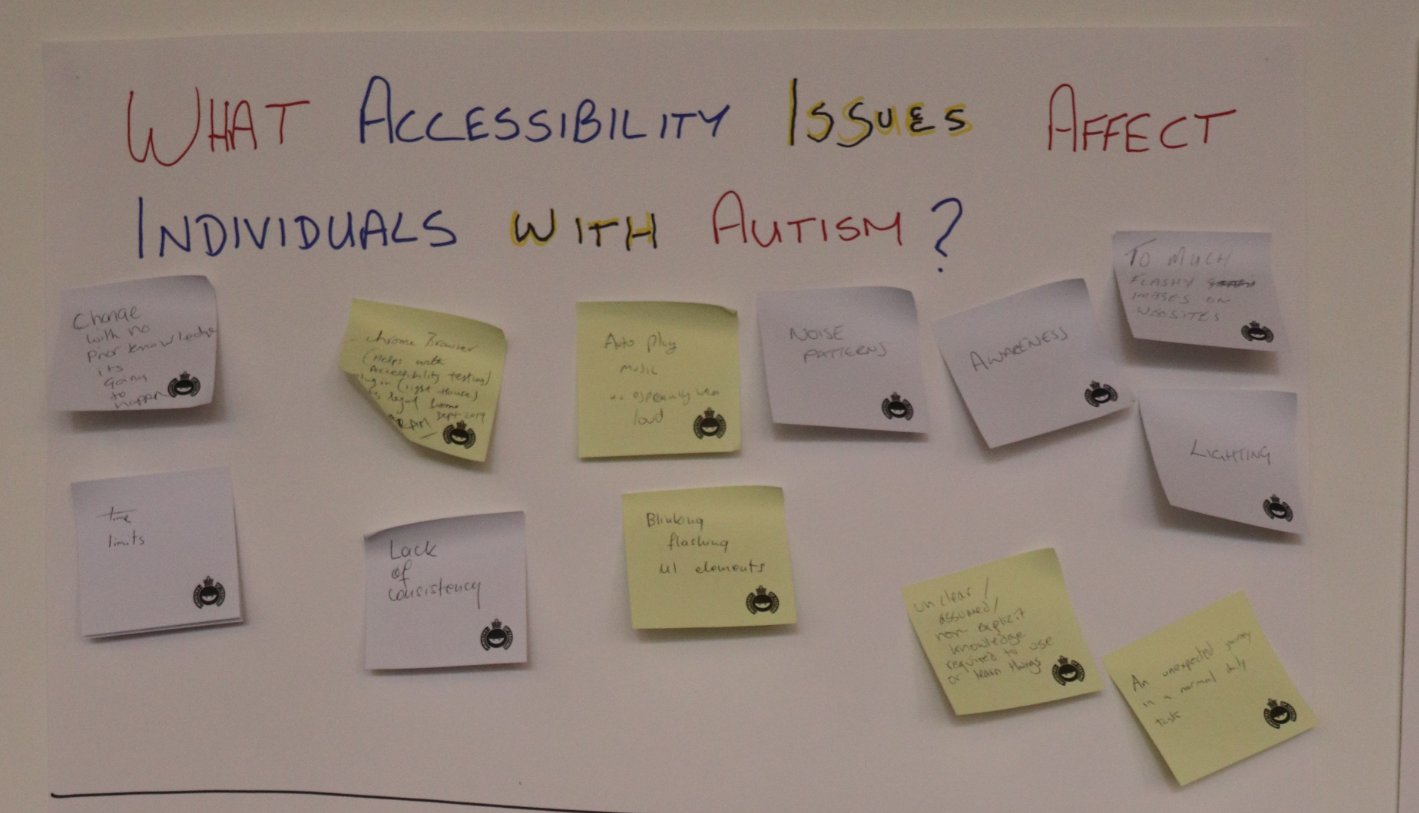Accessibility... What About Autism?
I'm back and I'm on a mission. "Yeh yeh, that old chestnut"
To be fair I never really went away, just focused on things other than my blog for a while. This time my mission is a little different. You may or may not be aware but I have an 8 year old Autistic son and he makes me proud every day (along with my other children). Along with my wife we have happily fought my sons corner to ensure he's getting the right support in the right way and at the right time.
As part of my personal aim to become better at public speaking I was lucky enough to be given the chance to speak at Testbash Brighton. This was as part of an amazing track of talks relating to mental health and well being by some of the most impressive speakers on some of the most challenging topics. I spent the prior 3-6 months working on my talk 'What can I learn from Autism as a tester' and whilst this was based on my own journey with my son and our experiences, I was amazed at just how much of the reflection and analysis I did surprised me. I don't think I'd say there was any big revelations to speak of but taking the time dig deep and understand from my own and also from alternative perspectives provided clarity you don't come across every day. This clarity has in turn driven my desire to try and make a difference in promoting and pushing inclusion, particularly for autistic people.
Now I'm not planning on replaying the talk in blog format but I will try to cover some of the learning and more prevalent points over future blog posts. What I would like to spend some time looking at now is the accessibility and inclusion aspect of my talk.
We can start by looking at more general accessibility issues and resources. Look at, understand and follow the standards on https://www.w3.org/TR/WCAG21/ as far as they are relevant. From my research and experience, the WCAG standards cover much of what is relevant for ensuring autistic accessibility but the interpretation of the standards can get blurry. Focus is often on the the standards that are much less ambiguous.... generally driven by lack of awareness on how to interpret these rather than conscious exclusion.
An interesting question often raised in relation to accessibility, particularly when considering it in the context of autistic people, is how do you account for the fact that this is a wide ranging spectrum and every autistic person is an individual?
In my honest opinion there is no perfect answer, but then there is very rarely a perfect answer to any question. I do however believe, we have a social responsibility to find the best path forward to drive inclusion in the best way possible. For apps, websites, software, games etc that means understanding and addressing accessibility as effectively as possible. Note, I am taking this challenge in relation to this website so you may see some updates over the coming months.
In the context of autistic individuals, accessibility needs thinking about a little more carefully but in my honest opinion many of the things that can help, will also help create an improved experience for everyone, not just autistic individuals.
Look at design and screen layout
Can you quickly and easily identify the options, the navigation and the information that are important to you? Have you avoided the clutter effect and kept the design as simple as possible focusing on relevant and useful content that benefits the users journey and aims. 'Clutter' generally refers to an overly busy page with lots content that is irrelevant, moves unnecessarily, distracts or otherwise makes it difficult to find what you are looking for. This might include unnecessary sounds or moving/animated elements of sites that may prove as an unwanted stimulant.
Use of language
Make sure any text or instruction is as clear and precise as possible. Try to consider if there is anyway it wouldn't be clear or could be taken out of context, maybe due to ambiguity or multiple meanings. If in doubt ask someone who doesn't know the context to read it and feedback on their understanding. The following site may help with English translated sites.
http://www.plainenglish.co.uk/free-guides.html
Visual Representation
Use of visual symbols/icons over text is common in education to support learning but is particularly important for autistic people. Visual representation used correctly presents information in it's simplest and most succinct form. My son has a PECS book with a selection of visual representations to support him asking for things. He is capable of asking without the aid of the book but at the height of his frustrations when he is overly stimulated, the book and the use of imagery help him to communicate where words and text fall short. If someone can identify what they are looking for at a glance because a simple image/visualisation makes it clear then the experience will be enhanced.
Avoiding Violation of Expectation
Violation of expectation is a big cause of many frustrations for any of us. For some autistic people (certainly for my son) that rely on structure and consistency, violating pre-built expectations can cause over stimulation and in my own experiences with my son, often result in melt downs and distress.
Examples of violation of expectation might be clicking something looking like a link and finding it's not a link, lack of consistency (maybe changing orders in menu's, using similar imagery/icons to represent different actions/activities, differences in mouse over actions), delays around loading actions such as adverts or unnecessary pop-ups.
Another big violation of expectation comes with change (tied into consistency). Introduction of gradual change is much more accessible for individuals who thrive on consistency than big bang changes, particularly if these big bang changes result in big changes to behaviour. Lets be honest, many of us find frustrations when Windows for example drastically change the way we access certain functions that we use regularly, for autistic individuals the impact and stimulation of that frustration is potentially increased. Not to say don't change things at all but these changes can be managed and implemented gradually (maybe with an option to turn new changes on or off) or where appropriate flagged up in advance of reaching the area affected. This isn't about perfection remember just awareness and consideration.
This doesn't necessarily fully answer the question on how improving accessibility might do a better job of catering for the spectrum.
An often overlooked option albeit not quite as simple to implement is the provision of something that would allow a user to personalise their experience in some way. This might be more micro personalisation on a page by page basis, allowing users to turn on and off aspects or behaviours on the site they may or may not want to see. Other alternatives might be the ability to just switch between a standard view and an accessible view for the whole site or on a page by page basis (some pages may be more inaccessible than others).
So those are some overarching guidelines but by no means exhaustive - the National Autistic Society Website has these and also some more useful links that will probably prove helpful - https://www.autism.org.uk/professionals/others/website-design.aspx
There was also an interesting case study (if you fancy a bit of light reading) around Webpage Accessibility and Usability for Autistic Users completed in Italy by Antonina Dattolo, Flaminia L. Luccio and Elisa Pirone.
https://core.ac.uk/download/pdf/80136806.pdf
Interestingly I also made use of a fantastic Testbash concept - the unexpo. For anyone unaware of what this is you can read more about last years unexpo here
https://www.ministryoftesting.com/news/the-unexpo-a-novel-approach-to-increase-conference-attendee-engagement-and-maximise-community-feels
I used my place in the unexpo to ask two questions:
- What accessibility issues affect individuals with autism
- Do you feel Autism is a barrier to employment?
I will go into the question around Autism as a barrier to employment in a later blog but the feedback on the first question was excellent and the conversations I was able to have around the question even better. Massive thanks to Ministry of Testing for allowing me to do this.
I've touched on most of the points directly or indirectly already but the photo is below:

Inclusion
So having talked about some general guidelines, it still feels like we are missing something fundamental with regards to inclusion and accessibility. Can we honestly claim to be addressing accessibility and inclusion without actually applying inclusion into the building and testing?
If I want to know what my son wants for his tea, I ask him. If I want to know where he wants to go or what he wants to do I ask him, sometimes I have to adapt the way I ask the questions or use approaches to get his engagement but ultimately he's the only person who really knows what he wants.
Surely then if we want to improve the experience of autistic people across the spectrum in technology, then we need to be getting autistic people from across the spectrum involved in the whole process. Is driving inclusion by inclusion such a radical concept?
There are options towards achieving this with some major companies driving programmes of change around employing autistic individuals. There are also companies who recruit autistic people as consultants to work with companies or to provide accessibility testing as a service (I'm more than happy to discuss this further if you want to drop me a line).
Is it a bad thing that our duty of care to ensuring inclusion in products drives inclusion in the workplace? After all employment rates for autistic individuals are only a little over 16%. For me that's bordering on negligent and something that needs addressing as a matter of urgency.





